Efficient Silage Making
Silage
making relies on anaerobic fermentation to convert sugars to organic acids. An anaerobic
fermentation
cannot take place in the presence of air. Where oxygen is present due to poor consolidation,
inadequate
sealing or where sheeting is delayed this process is slow, inefficient and wasteful resulting in
high dry matter losses. Often there will be top surface waste, a poorer fermentation in the top
third
of the clamp combined with with heating and spoilage on the face. This is especially so when
relying
on bacteria naturally present on the crop to carry the fermentation.
Fermentation can only begin when there is no air in the clamp
On the other hand the use of a silage inoculant or biological additive together with rapid filling, good consolidation and an effective air tight sealing will generally result in a very fast and efficient fermentation with minimal losses of dry matter. The result being a well fermented silage with minimal waste, more feed value and excellent intake characteristics. A silage inoculant or additive supplies selected elite strains of bacteria which are capable of rapidly fermenting sugars to acids much more efficiently than will take place in an uncontrolled fermentation. This could be likened to running a race with an Olympic athlete set against an 'old codger from down the village'.
Rapid fermentation reduces losses, and makes better silage
Always use an additive
Dropping the pH to below 5 in a matter of hours deactivates protease enzymes preventing protein breakdown and dramatically reduces the multiplication and activity of a wide range of spoilage organisms including clostridia, yeasts and moulds. With an inoculant, within a day or two the pit will be dropping towards 4 pH and becoming stable. This compares with up to 6 - 8 weeks for untreated clamps. A silage inoculant will rapidly drop the pH without wasting vast amounts of nutrients on heating the silage clamp for weeks on end. Whether or not an additive is used the fermentation cannot begin until there is no air in the clamp. That is why using good quality silage films and covers is so important.
Any air in the clamp will delay the fermentation and dramatically increase
losses.
Make sure that the clamp really is air tight
It
is not unusual to find silage clamps where the top metre or two of silage is low in quality
compared
to the bottom metre of the pit, due to impaired fermentation caused by oxygen presence during the
early
part of the fermentation. Often the these top layers are prone to heating on the face and are
contaminated
with mycotoxins. Not only will these
contaminated layers have reduced feed value and poor intake characteristics
they may cause the TMR or complete diet to heat. This can result in a loss of milk yield of up to
5
litres along with all sorts of knock on effects on cow health and fertility.
Inadequate sealing can represent a massive loss in output and profitability
Keeping Air out of Silage Clamps
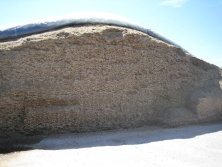 The
amount of air in the pit depends on a wide range of factors. Firstly dry matter % is obviously
important. Below 25% DM most of the spaces between the particles of silage will be taken by
liquid. Above
30% DM unless the clamp is extremely well consolidated air can penetrate up to 1 - 2 metres from
the
surface or face with relative ease.
The
amount of air in the pit depends on a wide range of factors. Firstly dry matter % is obviously
important. Below 25% DM most of the spaces between the particles of silage will be taken by
liquid. Above
30% DM unless the clamp is extremely well consolidated air can penetrate up to 1 - 2 metres from
the
surface or face with relative ease.
Obviously wet, short chopped, leafy material, low in fibre will consolidate much better than dry, long chopped, stalky material.
Packing density is important. Ruppel, 1992 showed that dry matter losses halved from 20% to 10% when packing density was doubled. That is equivalent to saving 100 tonnes of silage for every 1000 tonnes clamped. More rolling with heavier machines on narrow tyres, rolling no more than 15cms of silage at a time will give the best consolidation.
Clamps should never be overfilled. Steep shoulders and slopes of more than 30o are almost impossible to roll. Wetter silage is much heavier than dry silage so putting some direct cut grass on top can be highly beneficial. The faster that filling is completed and the clamp is sheeted and sealed to exclude oxygen the better.
Covering Systems for sealing Silage Clamps
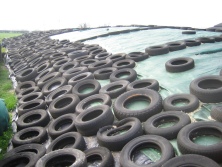 Richard
Webster has looked at hundreds of silage clamps every year for
the past 35 years. it is quite clear that some farms produce silage with virtually no visible
waste and excellent fermentation characteristics year in year out, whilst others make silage which
has
top waste and a very average fermentation most of the time.
Richard
Webster has looked at hundreds of silage clamps every year for
the past 35 years. it is quite clear that some farms produce silage with virtually no visible
waste and excellent fermentation characteristics year in year out, whilst others make silage which
has
top waste and a very average fermentation most of the time.
This is probably one of the reasons why the top 10% of farms have always made double the profit per cow compared with the bottom 10%. Attention to detail. Basically there is nothing that the best silage makers are doing that can't be done by the whole industry.
Stating the obvious, oxygen will only stay out of the clamp if there is an impermeable, air tight barrier between the silage and the outside air. If the edges aren't air tight, if there are holes in it, if there are air pockets under it, if there are gaps at the edges, if it is permeable to air then air will get through. On outside pits where the wind constantly changes in pressure much more air will get through.
If the clamp does not have a truly air tight seal, then there will be losses and waste
Both
standard black silage sheets and thin clear polythene cling films are both permeable to air. In fact black plastic sheets have
been shown to be capable of transmitting around 2 litres of oxygen per square
metre per day across the whole sheet and clear polythene cling film sheets around 10 litres of
oxygen
/ m2 / day. Even putting several sheets on will allow significant amounts of oxygen
into the clamp.
When we consider that average dry matter of grass silage over 30 years has risen from 22% to 32%, we make more dry wholecrops and maize silages, we have more outside clamps, we use far fewer tyres, we have less labour available to do a proper job of sealing the clamp, then it is not surprising that despite the massive technological improvements in silage additives, silage making techniques, machinery, nets, silage films and silage covers and gravel bags we still have a major problem with waste and excessive dry matter losses in silage clamps. Good quality silage sheets and covers really do make a massive difference to losses.
Despite massive technological improvements, we still have a major problem with excessive losses in silage clamps
Fortunately there is a cost effective solution. For a number of years Richard Webster Nutrition has been promoting a completely new type of sheet, Low Transmission Oxygen Barrier Film from Passion Ag or Silostop.
Oxygen barrier films
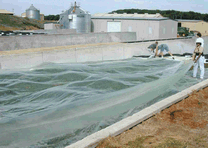 Low transmission
oxygen barrier film were
developed in Italy and were a major break through in consistently producing high quality silage.
Low transmission
oxygen barrier film were
developed in Italy and were a major break through in consistently producing high quality silage.
The Passion Ag and Silostop low transmission oxygen barrier films are quite different from other clear cling film type sheets made of polythene and which do transmit oxygen.
These oxygen barrier films are just as effective as standard cling film type sheets at clinging to the silage surface but unlike other clear films or black plastic sheets, oxygen barrier films do prevent the transmission of any significant amounts of oxygen into the silage surface.
"Oxygen Barrier Film has been the most important development in silaging during the past 45 years. It has given us the means to exclude oxygen out of the silage clamp " - Keith Bolsen, Professor Emeritus Kansas State University.
The ONLY true Oxygen Barrier Films for Silage
Types of Silage Sheets available in the UK
There are many branded silage sheets and cling film products available in the UK, many claiming to be as good, better or cheaper than the Passion Ag or Silostop low oxygen transmission silage films. This can be very confusing. Basically silage sheets fall into 3 distinct categories.
- Black Plastic sheets made from polythene, usually recycled, coloured black to protect them from sunlight. Black plastic is water proof but is porous to air transmitting large volumes of air into the silage clamp especially on windy sites.
- Cling Film products made from clear virgin polythene. These silage cling film products are thinner than black plastic sheets sealing better at the edges and forming to the silage more effectively than the thicker black plastic. They are waterproof, but transmit several times more air than black plastic sheeting and are easily damaged.
- Low Transmission Oxygen Barrier Films are almost as strong as black sheets and almost as thin as cling film products. As well as being waterproof these films are a genuine oxygen barrier transmitting minimal amounts of oxygen even on windy, exposed sites. These are the only silage sheets or silage films with extensive independent research demonstrating their ability to exclude oxygen, improve silage fermentation characteristics and consistently reduce silage losses compared with other sheeting systems.
Silage losses occur when oxygen is not effectively excluded during the fermentation
The benefits of using Oxygen Barrier Film have been scientifically proven by a number of research centres in the UK, the USA and across Europe.
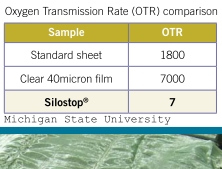 Tests
on oxygen barrier film at Michigan State University forage research centre showed dramatic reductions in
oxygen
transmission compared with other silage sheets.
Tests
on oxygen barrier film at Michigan State University forage research centre showed dramatic reductions in
oxygen
transmission compared with other silage sheets.
Oxygen barrier film has proven extremely effective at reducing or eliminating top waste on grass silage, wholecrop, maize and crimped cereals on commercial farms. Low transmission oxygen barrier films should not be confused with cheap low density polythene films. Oxygen barrier films have been shown in over 40 trials to reduce dry matter losses by up to 50% in the top layers of silage.
Oxygen Barrier Films are up to 1000 times better than conventional clear plastic silage films at preventing oxygen transmission
Check out the low oxygen transmission rates and research on the Passion AG OB Film Brochure.
Oxygen Barrier films are often used underneath a conventional black plastic sheet to protect them from UV light. Since the objective is to exclude oxygen particular attention should be paid to sealing the edges and to protecting the sheet from damage, making sure that all silage sheets, covers and protective nets are secure and that edges are well sealed. Use gravel bags on seams, shoulders and edges and for best results weight the sheets with tyres or lorry tyre sidewalls across the whole silage clamp surface.
Low Transmission Oxygen Barrier Films Reduce Silage Losses
 Trials with Oxygen Barrier Film at the University of Nottingham showed that where
oxygen barrier
film was used instead of conventional black plastic sheeting on 1700 tonne silage clamps, silage judged to be inedible and
discarded
was 0.1% compared with 5.9% or 1.7 tonnes compared with 100 tonnes.
Trials with Oxygen Barrier Film at the University of Nottingham showed that where
oxygen barrier
film was used instead of conventional black plastic sheeting on 1700 tonne silage clamps, silage judged to be inedible and
discarded
was 0.1% compared with 5.9% or 1.7 tonnes compared with 100 tonnes.
Assuming an additional cost of around £400 for oxygen barrier film and a cost of £40 / tonne for silage this would save more than £3600 per clamp giving a return on investment of around 9:1 even before taking into account improvements in silage feed quality and animal performance.
Low Transmission Oxygen Barrier Film is much more effective than Cling Film
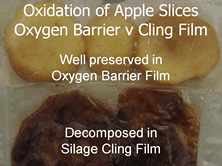 Apple slices shrink wrapped in low transmission oxygen barrier film preserved well even after 6 months in warm conditions.
Apple slices shrink wrapped in low transmission oxygen barrier film preserved well even after 6 months in warm conditions.
The same apples shrink wrapped in standard polythene silage cling film quickly discoloured and were completely rotted and decomposed within a few weeks.
No wonder that a quality oxygen barrier reduces dry matter losses and top waste in silage.
Not all Oxygen Barrier Films are equal
 A comparison of Passion Yellow Oxygen Barrier Film versus another widely available Oxygen Barrier Film clearly demonstrated that not all oxygen barrier films are equal.
A comparison of Passion Yellow Oxygen Barrier Film versus another widely available Oxygen Barrier Film clearly demonstrated that not all oxygen barrier films are equal.
The Passion Yellow Film prevented deterioration apples much more effectively than the other film.
We strongly recommend Passion Yellow Oxygen Barrier film for use on all silage pits. Grass, wholecrop, maize and crimped cereals.
Passion Yellow OB Film has been shown to out perform other films
A recent review of over 50 trials comparing oxygen barrier films with standard polythene clearly demonstrated not only reduced dry matter losses but also improved aerobic stability with the top layers of silage staying cool for 60 hours longer.
Oxygen Barrier can improve aerobic stability by up to 2.5 days
45 micron low transmission oxygen barrier is available either as Passion Yellow or Silostop Orange Silage Sheets. Whilst strength is comparable to conventional 100 micron black plastic sheets, 45 micron oxygen barrier films are much better at moulding and clinging to the silage surface and much better at sealing at the edges than conventional 100 micron black silage sheets.
Passion Yellow oxygen barrier films and Silostop Orange oxygen barrier films are designed for use either under standard black plastic silage sheets or under a close weave anti-UV protective net. We consider these to be the best option currently available for effectively sealing a silage pit.
Passion Supreme or Silostop Max are 2 in 1 films. These thicker multi layer 100 micron oxygen barrier sheets are designed for use where only one sheet is used with or without a net. These 2 in 1 oxygen barrier sheets offer a convenient option for use where a single sheet is preferred for ease of handling.
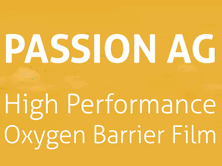 For best results, our preferred option is to use 45 micron Oxygen Barrier Film, then fold over side sheets and then apply a conventional black sheet. Cover with a protective net. Use gravel bags around the edge of the pit then cover with lorry tyre sidewalls, across the whole surface. This generally produces a completely air tight seal with no top waste and greatly reduced dry matter losses in the top metre of silage.
For best results, our preferred option is to use 45 micron Oxygen Barrier Film, then fold over side sheets and then apply a conventional black sheet. Cover with a protective net. Use gravel bags around the edge of the pit then cover with lorry tyre sidewalls, across the whole surface. This generally produces a completely air tight seal with no top waste and greatly reduced dry matter losses in the top metre of silage.
Silage Oxygen Barrier Film Testimonials:
A R Cox & Son, Manor Farm Staffordshire and JM & SE Jackson, Longpools Farm, Shropshire
More information on the use of silage covers - Passion Ag FAQs.
Use a genuine oxygen barrier film as a matter of course for superb quality silage
Oxygen Barrier Films Reduce Losses in Silage Clamps
Oxygen Barrier Films can be used in various combinations with other covers either with or without tyres. One of the best combinations is Oxygen Barrier Film, covered with a black sheet and Protective Silage Nets using gravel bags or Lorry Tyre Sidewalls to seal the edges and apply an even weight to the clamp surface. They make the best and most effective silage pit covers dramatically reducing top waste on silage pits.
As well as being effective on a wide range of ensiled crops oxygen barrier films are particularly useful for controlling spoilage and top waste on moist feeds as can be seen from the picture here.
Feed value savings from using oxygen barrier films are far greater than
the additional cost
compared with cheaper clear silage cling films
 A clamp of high quality
forage is very valuable. A little additional time and effort in sealing the
clamp together with a little additional investment in additives, oxygen barrier films, sheets, nets and covers can make
all
the difference between a below average product with high dry matter losses, poor fermentation,
mycotoxins,
spoilage and heating on the face, or a superb, stable, feed with excellent intake characteristics
capable of supporting very high levels
of performance and milk yields with less reliance on concentrates.
A clamp of high quality
forage is very valuable. A little additional time and effort in sealing the
clamp together with a little additional investment in additives, oxygen barrier films, sheets, nets and covers can make
all
the difference between a below average product with high dry matter losses, poor fermentation,
mycotoxins,
spoilage and heating on the face, or a superb, stable, feed with excellent intake characteristics
capable of supporting very high levels
of performance and milk yields with less reliance on concentrates.
The ONLY true Oxygen Barrier Films for Silage
Types of Oxygen Barrier Film
In summary, there are basically 2 types of oxygen film available in the UK
- Oxygen Barrier Film to use under a black plastic silage sheet such as Passion Yellow or Silostop Orange. These have the advantage that sealing with 2 sheets sandwiching a side sheet between is much more effective than using a single sheets. There is also less chance of oxygen or water transmission through holes in the sheets.
- Two in one combination oxygen barrier sheets such as Passion Supreme or Silostop Max. These have the advantage of only one sheet to apply but more chance of air getting in through holes and at the clamp edges. Cost of the two systems is similar. Both systems are effective with careful attention to sheeting up but generally in our experience the two sheet system makes the best silage .
Silage losses occur when oxygen is not effectively excluded during the fermentation
Passion Yellow OB Film
 Passion Yellow is an ultra-thin (45 micron) silage oxygen barrier film engineered to drape and cling tightly to your silage surface. Despite being only 1.8 mil thick, it’s incredibly strong and 1000 times more effective at blocking oxygen than standard silo plastic.
Passion Yellow is an ultra-thin (45 micron) silage oxygen barrier film engineered to drape and cling tightly to your silage surface. Despite being only 1.8 mil thick, it’s incredibly strong and 1000 times more effective at blocking oxygen than standard silo plastic.
This high-performance oxygen barrier film eliminates air pockets by conforming to every nook and cranny of the pile, creating an ideal anaerobic environment for fermentation.
Passion Yellow Oxygen Barrier Film
- Unmatched Oxygen Barrier: Advanced multi-layer technology gives Passion Yellow an oxygen transmission rate near zero – about 1000× lower than conventional covers. This means significantly improved fermentation and far less mould. In fact, research shows that using an oxygen barrier film can cut inedible spoiled silage by up to 72%, translating to more feed in the bunk and higher milk or meat production.
- Ultimate Cling Performance: This film drapes and sticks to the silage like no other. By hugging every contour, it eliminates air pockets that would otherwise foster spoilage. Unlike stiffer and thicker sheets that can bridge over valleys, Passion Yellow’s cling ensures zero gaps for oxygen to lurk. The payoff for farmers is a tighter seal and more silage preserved in peak condition.
- Lightweight & Easy Handling: At a fraction of the thickness of ordinary covers, Passion Yellow is much lighter per square meter. Rolling it out over a clamp is quicker and requires less manpower. Labour and time savings during covering and uncovering mean lower costs and faster silo turn-around.
- Robust: Don’t be fooled by its thin profile – Passion Yellow is built tough with a special resin blend that provides excellent stretch and resistance to tearing, allowing it to be walked on just like thicker films. When used as intended (under a protective sheet), it lasts the entire storage period without deterioration, keeping your silage protected from filling to feed-out.
Superior Silage Preservation:
 By keeping oxygen out, Passion Yellow drastically reduces top-layer spoilage – studies have shown up to a 50% reduction in dry matter losses in the top layers when true oxygen barriers are used. The result is preserved yield, nutrients, and palatability for your livestock, instead of feed turned to waste.
By keeping oxygen out, Passion Yellow drastically reduces top-layer spoilage – studies have shown up to a 50% reduction in dry matter losses in the top layers when true oxygen barriers are used. The result is preserved yield, nutrients, and palatability for your livestock, instead of feed turned to waste.
Passion Yellow gives you the confidence that your silage is as protected as possible from the number one enemy – oxygen.
By investing in this high-performance oxygen barrier film, farmers can save more of their hard-earned crop, improve forage quality, and ultimately increase milk/meat output from the same forage. It’s a simple addition to your silage routine with profound benefits. Choose Passion Yellow as the foundation of your silage cover system and enjoy significantly less waste and higher feed value from every pile.
With dramatically less top spoilage, more dry matter recovered, and improved forage quality, Passion Yellow quickly pays for itself. Every percentage point of dry matter saved is money in your pocket. For example, reducing losses by 8% in a 1000-tonne silo yields ~80 extra tonnes of feed – real savings that far outweigh the cost of the film. By preserving more of what you grew and harvested, using Passion Yellow boosts your bottom line.
Passion Yellow is best used as the inner layer of a multi-layer silage covering system.
After filling your silage clamp, place Passion Yellow directly on the silage surface, draping it down along walls and into corners. Its clingy nature works on all types of forage. Because it’s not UV-stabilised for long-term exposure, it must be shielded with a UV protective top cover (e.g. a black sheet or Passion Woven/Fleece cover) to prevent sunlight damage and physical tears. Ensure you overlap sheets if using multiple rolls, and weigh down all edges with Passion Gravel Bags or lorry tyre sidewalls to maintain an airtight seal.
Unmatched Oxygen Barrier: Advanced multi-layer technology gives Passion Yellow an oxygen transmission rate near zero – about 1000× lower than conventional covers.
Passion Yellow oxygen transmission rate near zero
about 1000× lower than conventional covers
Passion Supreme OB Film
 Passion Supreme is a dual-purpose silage film that provides both a high-performance oxygen barrier and a UV-protective top layer in a single sheet.
Passion Supreme is a dual-purpose silage film that provides both a high-performance oxygen barrier and a UV-protective top layer in a single sheet.
At 95 microns thick, it blends the cling and sealing performance of an inner oxygen barrier film with the durability of a traditional outer plastic. This all-in-one approach offers ultimate convenience – instead of deploying two layers (oxygen barrier film + cover), you can cover your silo in one step.
All-in-One Protection: Passion Supreme’s multi-layer construction includes a true oxygen barrier core plus a tough, UV-stabilised outer layer. It seals out oxygen to preserve your silage quality, and it withstands sunlight and weather on its top surface. This means you get the effective oxygen sealing of products like Passion Yellow along with the UV protection of a top sheet, combined in one roll.
With only one sheet to unfold, application is quicker and easier. Covering the pit can be done in nearly half the time since you don’t need to first apply a thin film and then a separate cover. This is a major benefit on large bunkers or when labour is in short supply. A small crew can get the job done efficiently. Quicker covering not only saves labour cost but also means the silage is sealed faster after filling (crucial for better fermentation).
Good Cling & Seal: Despite being thicker than Passion Yellow, Passion Supreme still offers effective cling performance to the silage surface. Its inner layer is designed to mould slightly to the forage, helping eliminate most air gaps. While the cling is not as extreme as the ultra-thin films, it is enough to ensure a tight seal when combined with proper weighting.
Passion Supreme is perfect for farmers who want high-performance silage protection with fewer steps. It is designed to be used with protective covers such as Passion Fleece, Passion Woven Covers or open nets to prevent damage from wildlife and severe weather.
To use, simply roll it out over the silage pile or clamp in one go. Ensure you have enough overlap between sheets (if multiple rolls are needed) and seal those overlaps with tape or gravel bags. Because it’s a single layer, pay attention to sealing the edges carefully – use Passion Gravel Bags along bunker walls and all around the perimeter to keep the film tight against the silage.
Passion Supreme gives them the benefit of an oxygen barrier without introducing an extra layer to manage.
Passion Supreme combines convenience and high performance.
Passion Silage Wall Film
 Passion Wall Film is a specialised silage clamp oxygen barrier wall liner designed to eliminate a commonly overlooked source of spoilage – oxygen getting in from the sides and top edges of your silage clamp.
Passion Wall Film is a specialised silage clamp oxygen barrier wall liner designed to eliminate a commonly overlooked source of spoilage – oxygen getting in from the sides and top edges of your silage clamp.
This wall film is extra thick and tough (100 microns), made to be draped along bunker walls and across the shoulders of the silage, where concrete or earthen bank walls can otherwise allow oxygen transmission.
Significant spoilage tends to occur along the pit edges and shoulders if not properly sealed. Passion Wall Film addresses this by providing an air-tight seal around the clamp.
By covering the silo walls with Passion Wall Film before filling, you create a continuous oxygen barrier from the walls to the top, greatly reducing waste at the silage shoulders and preserving more feed. Despite its impressive strength, it’s formulated to be lightweight enough for easy handling during installation.
The result is dramatically less spoiled feed on the edges – studies found using sidewall plastic halved the losses of silage near the walls compared to no side liner. That means more tonnes of quality silage, especially from the usually problematic upper shoulders.
Rugged & Puncture-Resistant: It’s thicker and stronger than standard sheeting, so when you press silage against it or when you walk on it during filling, it won’t easily tear.
Uniquely, Passion Wall Film manages to be heavy-duty yet relatively lightweight and flexible. One or two people can still handle and hang it because the material is optimised for a good strength-to-weight ratio.
By using wall film, you effectively eliminate the usual band of spoiled silage at the top edges of the silo. That means no open avenue for air at the sides and at the shoulders. Consequently, the silage in the corners and edges ferments well instead of spoiling.
The film improves fermentation near the walls by blocking oxygen – reducing spoilage.
RWN Protective Silage Covers and Nets
When using oxygen barrier systems it is essential that edges or sheets are well sealed and that there are no holes in the sheets.
We offer a wide range of Protective Silage Covers, Nets and Gravel Bags. These are designed to protect plastic silage sheets and films from holes caused by birds, cats and dogs as well as from any other accidental physical damage which would allow entry of oxygen or water in to the silage pit.
We also offer Lorry Tyre Sidewalls which are the best option for weighting the whole clamp surface to reduce surface waste.
BETTER SILAGE, REDUCED FEED COSTS, MORE MILK AND LESS HASSLE
More Effective Clamp Sealing Systems
Always use an effective Silage Additive. For advice on Making Better Silage and reducing feed costs, contact Richard Webster.
